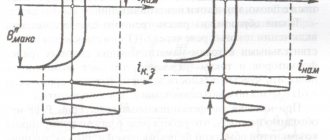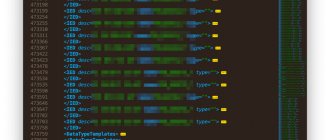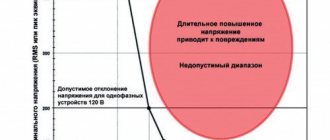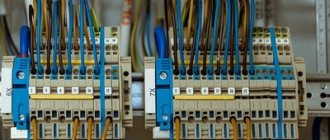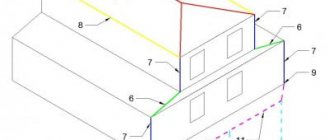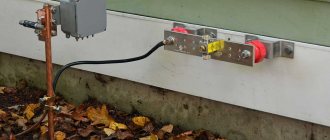A large amount of equipment and household appliances installed in apartments and private houses significantly increases the likelihood of electric shock, wiring fires, and equipment failure due to network faults. Protective devices - circuit breakers and RCDs - help to avoid unpleasant consequences. If the wiring or the household appliance itself malfunctions, a leakage current occurs, also known as differential current. In order for the protection to be as effective as possible, it is necessary to correctly select the characteristics of the RCD. The choice of parameters of a protective device depends on its intended purpose and the characteristics of the home electrical network.
What is an RCD?
First, I’ll answer this basic question. “ RCD ” is an abbreviation that stands for “ Residual Current Device ”. RCD is also called this:
- Differential switch (the abbreviation “VD” in the name and on the RCD body comes from these words),
- Residual current switch (RCB),
- Residual current device,
- Differential protection switch,
- Automatic circuit breaker controlled by differential current.
From the name it is clear that the main properties of this device are to distinguish (differentiate), turn off, and protect.
And if you want to find out official information on RCDs, refer to GOST R 51326.1-99 .
Update. From 01.03.21 GOST R 51326.1-99 is not valid. Instead, GOST IEC 61008-1-2020 . For electromechanical RCDs (independent of supply voltage), there is additionally GOST 31601.2.1-2012 , for electronic ones - GOST 31601.2.2-2012 .
For RCBOs, the new GOST number is GOST IEC 61009-1 –2020.
How does it work
The differential current appears due to free carriers and the electric field that appears when the cable insulation is broken or the wire connection is of poor quality. It moves along electrical wiring or semiconductor elements in the form of LEDs and a processor. In this case, a metal can act as a conductor, and a semiconductor can be an element of silicon, germanium, gallium, etc.
Operating principle
What needs to be protected?
If we are talking about RCDs , then you need to understand that we are protecting people first of all. We protect against direct contact with parts of equipment and electrical wiring that contain dangerous potential. The potential there may be normal, to ensure normal operation (as at the phase terminal of a socket), or it may appear as a result of an accident (for example, 220 V may appear on the body of a washing machine due to poor insulation of the heating element).
PUE recommends installing RCDs on all outlet lines (PUE 7.1.71) , but usually they are not installed in dry rooms. But I think it’s better not to save money, but to put them on each group (line).
RCD is an additional protection against direct contact. The main protection against direct contact is primarily insulation and a circuit breaker. Everything is clear with insulation, but the machine should work if a phase hits the ground.
“It should” - but it won’t always succeed, since the short circuit current is sometimes insufficient to work on electromagnetic protection, but on thermal protection it can work in a second, or in an hour, or never. I have written about this more than once. In this case, it is necessary to install an RCD (PUE 7.1.72) .
The protection works on the principle of comparing the difference (differential) of currents in phase and zero. Current can “leak” for various reasons - poor insulation, short circuit, touch - but in all cases, if the leakage current is sufficient, the RCD will de-energize its line.
Here we can recall Kirchhoff’s first law for a closed loop, which can be expressed as follows: the current “flowing” from the power source is equal to the “flowing” current. If these currents are not equal, then there is a leak somewhere and the RCD should react.
By the way, leakage can occur not only from phase to ground. It can be from the neutral wire or to another phase. In any case, if the current finds a “loophole” and begins to leak out of the closed circuit, and when a certain value of the leakage current is reached, the RCD will turn off.
Current appearance area
Physicists have not precisely given the concept of a differential current value, so it is as close as possible to the concept of a short circuit. It, in turn, occurs due to high voltage, poor insulation of electrical elements, external mechanical influence, the presence of foreign objects in electrical conductors and a direct lightning strike. A similar phenomenon appears in both home and industrial networks. Accompanied by sparks, unpleasant odors and damage to electrical equipment.
Sphere of appearance
RCD, differential circuit breaker and RCBO - what is the difference?
All these devices successfully perform the function of switching off in case of current leakage, and have the letter “D” in their name - differential. The difference is that differential automatic machines have additional built-in overcurrent protection. That is, they additionally protect against overload currents and short-circuit currents, having a thermal and electromagnetic release on board.
Three differential protection devices - HP, IM, RCBO
In terms of functions, everything is simple, but in real life it may not be possible to distinguish RCDs from differential automatic devices the first time. I'm telling you.
The main external signs of an RCD (differential switch, VD):
- The RCD has the designation “VD” in its name - differential switch. True, only manufacturers who use Russian letters in their names have this.
- RCDs do not have a protective characteristic letter in front of the rated current value (most often this is the letter “C”).
- For RCDs, the letter “A” is written after the current value. Examples – 16A, 25A, 32A.
- On the side wall of the RCD they sometimes write “Differential Switch (RCD)”.
- The diagram indicated on the RCD body does not include designations of thermal and electromagnetic releases.
The main external features of differential automatic machines (IM and RCBO):
- The model name on the body always contains the letter “A” (BP, RCBO).
- The letter of the protective characteristic is always indicated (B, C, D).
- After the rated current, the letter indicating amperes is not placed. Examples – C16, C25, C32.
- On the side wall, as a rule, it is written that in front of us is a machine gun.
- The diagram shows the thermal and electromagnetic release.
The differences in the HP, IM, RCBO circuits in terms of the presence of releases and overcurrent protection are visible below:
HP, IM, and RCBO - protection circuits are available only on the 2nd and 3rd circuits
differences between AD difavtomats and RCBOs , except perhaps in design. The IM has a series-connected circuit breaker and RCD in different housings, connected into a monolithic structure. AD is a more compact device.
The main external difference between differential protection devices and conventional circuit breakers is that in addition to the rated current In, the rated differential current IΔn (10, 30, 100, 300, 500 mA) is indicated on the HP, IM, RCBO.
By the way, PUE 7.1.76 directly states that it is recommended to use an RCD with an overcurrent protection device as a single device. This is necessary in order to guarantee the presence of protection and the correct protection current. After all, the consumer can install the machine at a higher current, or not install it at all. You never know.
In the second part of the article, we will consider the internal structure and differences of differential protection devices in more detail.
Main characteristics of RCDs and Difavtomats
Characteristics marked on the RCD body
As an example in which I will show various characteristics, let’s take the TEXENERGO VD67 2P 16A/10mA .
Let's see what inscriptions and signs are located on its body.
RCD (differential switches) TEXENERGO VD67 and VD1-63. Front Panel Features
- TEXENERGO is a trademark. Anything can be written here, the essence remains the same.
- The orange button with the letter “T” is the “Test” button. When it is pressed, a leakage current is artificially created through the built-in resistor. The RCD should turn off. The consumer must carry out such a test himself, which is extremely inconvenient. But this must be done - after all, the RCD may fail, and at the right time it will not save you from electric shock.
- VD67, VD1-63 – RCD model (series).
- Rated current In (in the photo - 16 A, 32 A). Standard range of values: 16, 25, 32, 40, 50, 63 A. This is the current that the RCD can withstand for a long time. In this case, the RCD must be protected from overcurrents by a circuit breaker with the same rated current, or one step less. For example, for the RCDs shown in the photo, circuit breakers of 16 (13) A and 32 (25) A should be installed. If the RCD operates on several groups protected by separate circuit breakers, then the sum of the rated currents of the RCD should not exceed the rated current of the RCD. You should not expect that a situation will not occur when all groups have maximum load power. For example, if the RCD is 32A, then there may be 2 circuit breakers (16+16, or 25+6 A) or 3 circuit breakers (16+10+6 A).
- Rated operating voltage Ue and rated frequency (∼230V 50Hz). For four-pole circuit breakers, this voltage is 400 V.
- Rated leakage current IΔn (30 mA) (rated residual current). This is the most important parameter for differential protection devices. Standard range - 10, 30, 100, 300 mA. There is also a non-breaking differential current IΔn0 , the value of which is usually (in real modular everyday life - always) equal to 0.5 IΔn . At IΔn0, leakage shutdown should not occur. In other words, shutdown can occur in the range of 0.5 IΔn < IΔ < IΔn. If the leakage current is higher than or equal to IΔn (IΔ ≥ IΔn), shutdown must occur in any case. The larger IΔn, the shorter the shutdown time. In GOST R 51327.1-2010, table. Clause 5.3.8 is specified more precisely - at IΔn the shutdown time is no more than 0.3 s, and at 5IΔn and more the shutdown time should be no more than 0.04 s. In real life, the shutdown time for all models at any current IΔ ≥ IΔn is less than 0.04 s (but this is not exact))
- Rated conditional short-circuit current Inc (6000 A). In circuit breakers, a similar parameter is called “Rated maximum breaking capacity”, and is designated Icn. Why “conditional”? The fact is that the RCD is not designed to turn off the circuit during a short circuit - this should be done by a circuit breaker in the same circuit. The higher the Inc parameter of the RCD, the better the quality of its contact system. The standard range of values is 3000, 4500, 6000, 10000 A. I don’t know what this is connected with, but the value of 6000 is indicated on the body of this RCD, and in its passport Inc ≥10000 A.
- Type of RCD according to the type of differential current. There are two main types of RCDs for leakage current. The first one is AC. This is the most common and cheapest type, for pure alternating current, indicated by a sine wave (∼) , as in the photo. The second is A, it reacts not only to alternating, but also to direct (unipolar) pulsating current. This is necessary when the load has semiconductor input power circuits. More versatile type. There are devices that respond to other types of differential current, but they are practically not used in everyday life.
- Temperature range (-25 °C) – minimum operating temperature.
Characteristics indicated on the body of the differential pressure control valve
As I already said, IM and RCBOs have the same functions and characteristics as VD (RCD), but with the advantage they have thermal and electromagnetic overcurrent protection, like conventional circuit breakers. So it's short.
In our example, the TEXENERGO AD67-2 differential protection device on the body has the same characteristics related to differential protection:
AD67-2-difavtomat TEXENERGO
The differences (except for the design, which will be discussed later) relate to overcurrent protection. The main difference is the inscription “C25”.
Characteristics indicated on the body of the differential automatic RCBO
RCBO TEXENERGO for rated current 16A
In principle, the same thing - rated current 16A, type “C” shutdown characteristic.
Next, we will consider the parameters of the RCD that are not indicated on its body.
Number of RCD poles
There are only two options here -
- two-pole (2p, or 2P), for single-phase supply voltage,
- four-pole (4p, or 4P), for three-phase networks.
Unlike conventional circuit breakers, here another zero pole is added as an RCD. Since zero is needed for the normal functioning of the RCD.
Operating principle of RCD
RCDs can be divided into electromechanical and electronic based on the principle of measuring differential current.
Electromechanical RCDs are more reliable because they do not depend on parameters and surges in the supply voltage, and operation occurs only due to differential current. Just like in circuit breakers - their operation depends only on the flow and action of overcurrent.
Electronic RCDs have electronic circuitry inside that is critical to power supply. They are a little cheaper than mechanical ones, since they have a relatively small differential transformer inside, which plays the role of a sensor, and the electronics cost a penny. And their reliability is not yet high.
A detailed article about the differences between electronic and electromechanical RCDs, and how they behave in the event of a zero and phase loss.
How to distinguish an electromechanical RCD from an electronic one? First of all, according to the circuit, which in an electronic RCD contains a triangle indicating an operational amplifier:
HP, BP, and AVDT. The differential current amplifier is indicated by a triangle
The differential current amplifier can also be designated by a rectangle, but it must receive power wires from the phase and neutral wires.
Here is the diagram indicated on the RCD body at the top:
The upper part of the RCD is a diagram of an electromechanical RCD
Rated maximum making and breaking capacity Im
In this case, this characteristic is equal to 630 A and means that the RCD can turn on, conduct and turn off without negative consequences for itself.
Rated maximum differential making and breaking capacity IΔm
This is the same parameter as Im, but related to the differential current. Usually IΔm = Im.
RCD selectivity
This parameter implies time selectivity of the RCD, although there may also be differential current selectivity. Both selectivities are used so that RCDs installed closer to the input respond later, and closer to the load – earlier.
The RCD selectivity is general and delayed. Table from GOST R 51326.1-99
Please note that a gross error was made in the table of this GOST - the minimum non-tripping time of an RCD with a time delay at 2IΔn should not be 0.006 s, but 0.06 s. This error has been eliminated in the new GOST IEC 61008-1-2020.
The TEXENERGO differential protection devices discussed in the article do not have a time delay (general type of selectivity). RCDs and differential circuit breakers with a time delay are designated by the letter “S” (Selective).
Installation standards
According to Russian standards, an RCD with a shutdown current of no more than 30 mA is installed for residential premises. The response time of the RCD, that is, the time from the appearance of leakage currents to the shutdown of the electrical circuit, should be in the range of 0.1-0.3 seconds; this shutdown time is sufficient to protect a person from death. But don’t think that with an RCD installed, you won’t feel the electric shock at all. There will be an electric shock, but the device must turn off the current in time and save your life.
I note that the same standards apply in Europe. In America, according to their National Electrical Code standard, RCDs installed in residential premises must have an operating current of 5 mA
Note: The serviceability of the device must be checked before installing the RCD, after installing the RCD and every six months using the “Test” button on the case. If, when you press the “Test” button, the RCD works, that is, it turns off the network, then it is fully operational. If it doesn't work, it needs to be replaced.
Download
For those who want to delve deeper into the topic, I am posting GOST, according to which RCDs (differential switches) are produced and selected. And a reference book on RCDs.
• GOST R 51326.1-99 / GOST R 51326.1-99 (IEC 61008-1-96) Automatic switches, controlled by differential current, for household and similar purposes without built-in overcurrent protection. Part 1. General requirements and test methods, pdf, 1.64 MB, downloaded: 1132 times./
• GOST R 50571.3-2009 (IEC 60364-4-41:2005) / GOST R 50571.3-2009 (IEC 60364-4-41:2005) Low-voltage electrical installations. Part 4-41. Security requirements. Protection against electric shock, pdf, 263 kB, downloaded: 1023 times./
• Dushkin N.D. and other RCD, educational and reference manual. / RCD - residual current devices, educational and reference manual., pdf, 8.44 MB, downloaded: 1581 times./
Let me remind you that the second part about the design of RCDs and automatic devices is here.
As always, I'd love to discuss!

